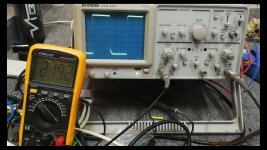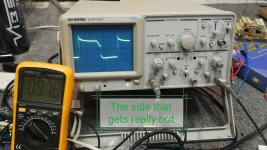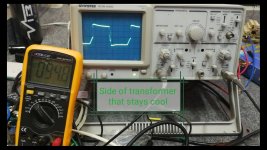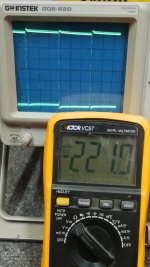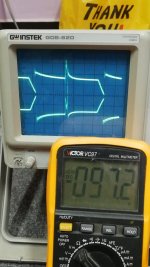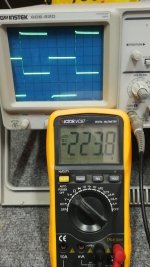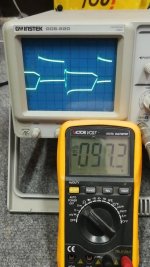Here you go
This pictures are from the side of primary that the mosfets connected to it gets really hot with high load :
Without any load :
View attachment 6707
With 37.5 Ohms load :
View attachment 6708
The other side of primary that stays cool:
Without load:
View attachment 6707
With 37.5 Ohms load :
View attachment 6709
I want to know where are you putting your probe is it on the gate of the IGBT or the ptrimary winding?
The first picture shows a beautiful wave form the the custom sloping trailing edge of an IGBT switch. Is this the full output winding or the input?
The side that is getting hot shows a very disturbed wave form and that is causing the heating of the IGBTs.
Please post pics with the probes on the gates. The signal must be clean here otherwise you will never get a good waveform on the output.
As the topology you are using is push pull then you can switch the gate wires if you have not done a pcb yet.
As you can notice There is ringing at the disturbed wave form when the IGBT is fully switched on, You must use a suitable snubber to calm things down, The more load you draw the more ringing you will get. avoid long wires or traces to the gates and away as possible from high current paths. These are to be at 90 degrees to the current path where possible to eliminate coupling. A double sided pcb with a ground plane will isolate any stray inductances that may couple to the gate drive.
Check your dead time and set for at least 2uS this will give either transistors time to fully switch off before the next turn on. You can make it less after things will be stable. Try also a piece of screened cable to drive the gates to eliminate any stray coupling. Use a gate emitter resistor of 1k to eliminate any false trigger.
If all this will not help then it could be a case of symmetry in the input winding. Push pull is very specific and the primary has to be uniform and symmetrical as possible otherwise you will be in for surprises.
I will send you some pics later of a commercial inverter of 3kw???? (I doubt it) to see how they make the ferrite cores.
Please post pics of probe at the gates and also at primary winding. if possible use two probes at the same time so that I see both channels together. (one time at the gates and one time at the windings)
Regards Silvio

